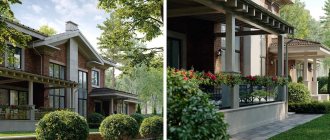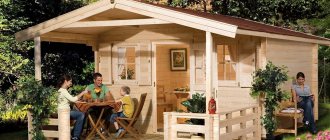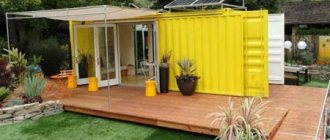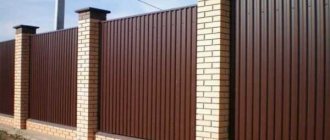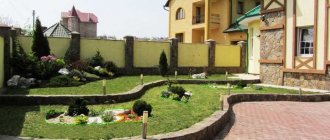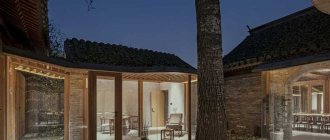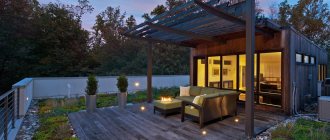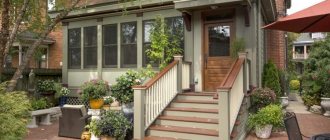Home » Type » House
House
Alyona
40091 Views 1 comment
About ten years ago, fireplaces began to be sold en masse - these are beautiful fireboxes of different sizes, made with a variety of decorative finishes. Thanks to the variety of types of portals, such fireplaces began to be installed in almost all private homes. Their beauty and high safety (the firebox is closed under glass) attracted many. For several years, they successfully replaced ancient Russian stoves. Till today…
Stove heating is still relevant
Despite the fact that now there are many ways to heat your home, a stove for heating a home does not lose its relevance. Beautifully made of brick, lined with stone or decorative tiles, the stove perfectly complements the interior of the house. A cast iron stove or fireplace also fits perfectly into the overall interior. Many people cannot even imagine their home without a good Russian stove. After all, how nice it is to warm up near the stove in winter, especially since there will always be a place where you can dry your shoes and clothes. Therefore, stoves have always been popular and will remain so for many years to come.
Important requirements that stove heating meets:
- fire safety;
- low consumption of fuel resources;
- duration of fuel combustion;
- ease of maintenance;
- heats up very quickly and at the same time retains heat for a long time and transfers it to the room.
Modern technologies are penetrating all industries - certain changes have also affected the furnace industry. Modern furnaces can be equipped in such a way that they can serve as a heating tank and a generator of electricity from fuel combustion. Many are designed in such a way that one stack of firewood is enough to maintain combustion for a long time.
Modern long-burning wood stove Source volgospas.ru
Features of masonry
A modern country house requires a special approach to the laying and design of such a complex and powerful heating unit. First they make a backfill - a chamber. It acts as a kind of battery, retaining heat in the house.
The cooking chamber is covered with a roof. It is designed strictly according to the formwork - plank or metal. When laying bricks, they are placed on both sides at once. The angle of inclination will depend on the shape of the arch. This is necessary so that the load is evenly distributed throughout the structure. At the end of the work, the master forms a wedge castle from brick.
The chimney is installed in the furnace itself. The height of the element must be higher than 5 m from the level of the blind hearth. There are no horizontal sections or turns needed. A well-formed vertical (like for a fireplace) is enough.
Stove heating of a private house
There are a huge variety of stove options. Here are just a few of them:
- cast iron stoves for heating;
- cast iron stoves for heating and cooking;
- cast iron stoves based on fireplace design;
- brick kilns "Shvedka";
- brick ovens for heating and cooking food;
- Russian stoves;
- brick fireplace stoves;
- Dutch brick stoves.
All these types have their advantages and disadvantages. Each stove for heating a home is good in its own way. Below is an example of a classic brick oven.
A carefully made stove will perfectly complement the interior of the house Source zen.yandex.ru
Advantages of the stove heating method
In order to understand the need to install a stove for heating a private home, you need to know a number of its advantages:
- absolute autonomy of operation and independence from external factors, such as turning off water, gas or electricity;
- brickwork can warm a room for a long time , even if the fire in the firebox has already gone out;
- simultaneously with heating the rooms, the stove can be used for cooking ;
- cost-effectiveness in terms of purchasing fuel and the need to pay bills for the general supply of gas, electricity and water, availability of firewood, compared to peat or coal;
- absence of overheated and dry air;
- just a pleasant atmosphere in the house;
- Ease of operation: no high-tech electronic equipment required.
The advantage of a brick oven is that it can be designed according to your wishes and preferences Source pinterest.com
Disadvantages of stove heating
Along with the advantages, stoves also have negative qualities.
- Sufficiently long heating time . This happens because bricks take a long time to heat up.
- A certain amount of usable space is lost , since the larger the house, the larger the stove will have to be installed.
- Heavy weight . If the stove is very large, you will have to build a separate foundation for it.
- Uneven heating of all rooms, that is, the further the room is from the stove, the more time it will take to heat it; warm air will reach it last.
What is taken into account when choosing
Choosing which stove to install is not so easy. Stoves are made of brick and metal. Usually cast iron is used as a metal: it holds heat the longest.
When choosing the dimensions of the furnace, its shape, and material, several factors should be taken into account:
- Number of heated rooms . For one or two rooms, a small metal stove is sufficient. For larger houses with more rooms, a brick oven should be installed. It can be supplemented with a water circuit that stretches through all the rooms. This option allows you to increase the efficiency of the stove, as well as heat all rooms more quickly and efficiently.
An example of the location of a stove in a small one-story house Source lestorg32.ru
- Dimensions of the room . It is logical to assume that a large brick stove will simply take up the entire space of a small room.
- The type of fuel on which the future furnace will operate. It can be gas, firewood, peat, coal. Combined devices are often used, but they have their own design and this must be taken into account.
In the old days, stoves were installed in the center of the house. They went out on each side into all the rooms, heating each of them. Massive stoves take a very long time to cool down, so after lighting you can be sure that all rooms will be heated. During installation, you will need to additionally cut a hole in the roof for the pipe to exit. In general, a place for a stove should be laid out at the stage of building a house. A well-chosen location is the key to effective use of the stove’s functionality, because it can not only heat, but also cook.
When designing a house, you can plan the location of the stove and design a pipeline for heating distant rooms and heating water Source luchtepla.ru
When choosing a stove for a country house, you will have to think through the following points:
- where the stove will be installed;
- what size will it be;
- how the chimney will exit: through the wall or through the roof;
- if the stove is brick, you will have to cut through the floor and prepare an additional foundation for it;
- provide fire safety measures;
A flooring made of non-combustible material is always installed near the stove. Source rmnt.mirtesen.ru
See also: Catalog of companies that specialize in insulating houses and installing fireplaces and stoves.
How to choose a stove for a red brick house - photo
If we are talking not only about heating, but also about complementing the interior, you can give preference to a round Irish stove. The thickness of the walls is ¼ stone. To give additional strength and increase heat transfer, a metal frame is “put on top”. It will strengthen the masonry and allow you to decorate the outer surfaces with forging.
If there are always people in the building, and there is a desire to cook food on wood or coal, you should choose a square or rectangular design, for example, Russian or Swedish. If you need a fireplace more as a stove for your home, pay attention to thin-walled Dutch or round Irish stoves. They are ideal if you don't need a special cooktop. And the front surface can be decorated with elegant tiles. They can become both an addition to the interior.
Do you want to stop using a gas stove? Variations of the Swede are at your service. They will warm you up and allow you to brew coffee over an open flame. The main thing is to correctly lay out and select the source materials.
Where to place the stove in the house
The main focus is on the design phase. The quality of the drawings determines the safety, performance properties, and aesthetic appeal of heating equipment. If you don’t have your own drawing skills, it’s better to turn to professionals. When choosing a place for placement, both the type of heater itself and the area of the cottage or part of it that is planned to be heated are taken into account.
Selection of working tools
Then you can move on to the tools. For work you will need:
- jointing With its help, concrete is poured into the seams;
- trowel;
- pick;
- shovel for mixing and supplying the solution;
- special line.
Materials
The next stage is purchasing the material. The heat transfer of the stove and its durability will depend on the quality of the brick. The rules are as follows:
- the outer surface is made of brick (grade M-500). They do not crack, do not lose their consumer properties during periodic heating or cooling;
- Only refractory bricks are suitable for the combustion chamber.
In addition, you will need sifted sand and high-quality clay.
Laying the foundation
Materials have been purchased. You can move on to the construction stage. It is important to understand that the stove must stand on a strong and high-quality foundation. It is better to lay it at the same time as the base of the entire house.
If the decision to build a Dutch or Swedish one is made only now, you will have to:
- dig a hole. On each side there should be at least 20 cm to the walls;
- level the bottom and fill it with sand, followed by thorough compaction;
- lay a waterproofing membrane;
- install formwork;
- pour concrete (1 part cement x 2.5 parts sand x 4 parts small crushed stone) to ground level. The surface of the foundation must be strictly horizontal;
- wait 5-6 days for the concrete to harden. After this, you can disassemble the formwork and lay waterproofing.
If, as a result, the foundation ends up below the floor level, it is leveled by additional pouring of concrete mixture. In the latter case, the formwork is rebuilt. The entire space around the foundation is filled with soil and thoroughly compacted.
Masonry process
First, a mixture of sand and clay, previously soaked, is prepared. It fills the gaps between the outer and inner walls. They are displayed separately, but there should be no spaces between them. The lowest rows are only made of solid brick and with a sling. Then the brick is cut taking into account the selected modification. The chopped side faces the inside of the masonry. To build a chimney you will need red burnt stones. Knowing the “castle” layout will not be superfluous. A brick chimney must be lined with a FERRUM stainless steel chimney to prevent the formation of condensation and premature destruction.
Is the oven built? There is no need to rush to melt it. You must wait at least 3 weeks.
Schemes and designs of stove heating in the house
Stove heating of a private house is divided into several types according to the design of the firebox:
- Straight-through . Basically, such stoves are made of brick. The principle of their operation is to pass a flow of air through the ash pan, then through the grate, maintaining the combustion of fuel, and then exits through the pipe, already in the form of smoke. The big drawback of this design is its very low efficiency: a significant part of the heat, in the literal sense, simply flies out into the chimney. Once-through furnaces are equipped with special valves that close when the fuel burns out and stops producing carbon monoxide. This allows you to maintain the heat for a long time. Also, to increase the efficiency, during assembly of the furnace, broken glass can be placed in it, which holds the temperature for a very long time.
- Channel . The main feature of such stoves is a system of channels through which smoke moves and uniformly heats the entire stove. Thanks to this solution, the entire structure heats up faster and retains heat well. The heating rate depends directly on the length of the channels and their number.
Channel-type brick oven Source yandex.ru
- Kolpakovaya . The operating principle is based on the movement of flow gases in a natural way. First, they fill the cap, where they cool and then come out on their own through a special cover. This allows the stove to heat evenly and quickly, which then retains heat for a long time, heating the room. Unlike the first two options, this design is easy to maintain. Soot can be easily removed from the hood through a special hole, whereas in the first two cases you will have to clean the chimneys and pipe, which is not very convenient.
- Water circuit . This is not a firebox design, but a fairly common element of the heating circuit that can be installed on any stove. You just need to add a heating tank to the firebox or a coil on the pipe.
Diagrams of various designs of brick kilns Source domvpavlino.ru
Russian hut and tower
The stylistic concept of “Russian hut” involves the use of wood. It can only be an imitation, but it must be skillful and thoughtful. In some ways, this direction is reminiscent of a loft, but it is much more dynamic and elegant than the “concrete jungle” style. The main difference from the previous style is that each decorative element has its own functional purpose.
A house in the “Russian tower” style is radically different from other styles. Planning plays an important role here. In villages, many people still decorate their yard in this style. Key features: the presence of garden decor, bright colors, ornate carvings, an abundance of tiles, colorful patterns, bright decor.
Types of furnace equipment
Furnace equipment refers to the structural elements that are used during the installation and operation of the stove. In cast iron stoves, they are already included in the kit from the manufacturer, but when connecting an additional water circuit to them, you will have to purchase additional elements for the stove:
- Pipes . These can be plastic or metal pipes. Preference is always given to metal ones, as they are more reliable, but plastic ones are cheaper. The disadvantage of plastic pipes is the possibility of their melting at the joints with metal. Metal ones do not have this drawback.
- Diaphragm (expansion) tank . It is necessary to maintain constant pressure in the pipes. When heated, the water begins to expand and enter this tank, so the pipes will not collapse from excess pressure. When cooling, excess water from the tank begins to gradually flow back into the pipes.
You can’t do without an expansion tank for any method of heating a house Source koffkindom.ru
- Radiators . They are usually installed directly under the windows. They increase the heat transfer of the water circuit.
- Water pump . It is required for water circulation in the circuit. Its installation helps to quickly heat the room, since the heated water quickly enters the radiators and heats the room. Without a pump, the movement of water through the pipes is carried out by gravity, but for this it is necessary to make special slopes, calculate the difference in heights and the difference in temperatures of the first circuit with heated water and the second circuit with cooled water - it is also called return.
- Heat exchanger . It is installed in the furnace firebox, above it, or on the chimney. All options have their advantages and disadvantages. This is a kind of boiler in which water will subsequently be heated. For chimneys, the heating tank is made in the form of a coil; for a firebox, it can have an arbitrary shape, but it is very important that it has a sufficient area of contact with the stove flame.
Scheme of operation of stove heating with a pipeline Source m.yukle.mobi
Three options for laying a stove with orders
Below is information regarding the construction of the main body of heating equipment. Laying the foundation is discussed in detail in the previous paragraph of this article. The most popular modifications are selected as examples.
Russian with a high bed
Settles in regions with cold and temperate climates. It is heated once/twice a day.
Below are descriptions of the rows:
- The first should be continuous using cement or lime mortar.
- Starting from the 2nd to the 4th, they begin to build a semblance of a well. On the front side there is a hole for baking. A prerequisite is the presence of a dressing.
- 5th - beginning of the arch. To lay it out, you will need shaped formwork, and the heels of the bricks will have to be pulled off. The operation continues in lines 6 and 7. In the 8th the vault closes.
- Rows 8 to 10 are laid out in one stone. At 11, the cold stove turns off. A layer of sand is poured on top. It should slope towards the rear.
- In the 12th, a continuous surface of refractory stone is laid out over the poured sand. This part of the firebox will be in direct contact with the fire. It is desirable that the floor is perfectly level. Does not work? You can add sand and sand the outer surface.
- Rows 13 to 16 are a crucible. Blocks - 3/4, with a sling. No masonry mortar is required at this stage. To make castles, the stones are cut to 450.
- Starting from the 17th line, the mouth and posterior surface are formed. The cooking chamber is being built. A brick with hewn heels is placed on its edge.
- 18th. The furnace walls are laid out. To fill the free space between the individual chambers you will need sand. You can add cut heels to it.
- 19th - laying out the vaulted opening above the pole. Behind it is the mouth.
- 20th - the walls are leveled. The hole above the pole is reduced. A cross-pipe is formed.
- The 21st row is no different from the 19th.
- 22nd - the vault closes. On the right is a chamber in which soot will accumulate. The view is also located here. With its help, the chimney is blocked so that the heat does not escape into the atmosphere too quickly.
- Lines 22 to 32 - laying out the overpipe, laying the view and building a chimney channel. The cross-section of the latter is 26x26 cm.
After this, all that remains is to remove the outer pipe and mount an additional damper. It will require a steel corner or strip 3 mm thick.
Semicircular chambers can be replaced with ordinary rectangular ones.
Improved "Teplushka"
All brick ovens have one common drawback - the walls heat up unevenly. Builders are trying to solve this problem by introducing changes to the design. This is how “Teplushka” appeared. After fuel combustion, part of the gas leaves the house immediately through the chimney. The remainder goes into the channels and is intended for space heating.
Heat transfer in comparison with the classic Russian modification increases immediately by 2.5 times. Structurally, “Teplushka” is closer to its bell-type analogues. The chamber is divided into 2 parts: food is prepared in the upper part, fuel is burned in the lower part. The floor itself is supported by pre-installed posts. Additionally, there are 4 openings on the sides to allow combustion products to pass through. The minimum chimney height is 5 meters. The countdown is from the bottom of the firebox.
The main differences from the traditional version are the displacement of the channel relative to the firebox. To remove cooled gas, special holes are laid at the bottom of the channel.
Important! The damper must be closed during cooking. You can use a special peephole.
The orders for the "Teplushka" are presented in numerous diagrams. The main requirement is that to increase heat transfer, the ceiling installed in line 21 is carefully covered with a mixture of sand and debris.
Simple stove with shield
This option is for those who want to build a stove at their dacha or in a small country cottage (no more than 20 square meters) with minimal costs, including temporary ones. The firebox is made of fireclay clinker, optionally red solid (provided that only coal will be used as fuel).
Cooking and burning fuel are in separate chambers. Gases pass through the cooking chamber and pass into the chimney. Photos of brick stoves for the home allow you to see in detail all the necessary masonry sections.
A horizontal channel is installed at the very bottom. Thanks to it, the air near the foundation warms up well. A microclimate favorable for humans is created in the room.
Wood stoves for heating a private home
Wood stoves have long been the most popular heating device because wood is often the most affordable heat source.
There are several types of ovens:
- with water circuit;
- simultaneously cooking and heating;
- long burning.
The choice of wood stoves can be made from the simplest in design to the most complex. Here are options for some of them:
- "potbelly stove";
- classic oven;
- pyrolysis oven;
- fireplace;
- wood burning boiler;
- a stove with a cooking surface;
- stove with the ability to burn wood for a long time;
- Russian stove.
Burning duration and surface temperature
There are two types of stoves, differing in burning duration:
- periodic combustion (fuel burns faster, it must be constantly added);
- regular burning firebox (fuel lasts for twelve hours).
Furnaces can be heated with coal, peat, wood, slate and other materials. The choice of fuel depends on the price of one type or another. Coal is very popular because when burned it produces a lot of heat and can heat any room.
A stove intended exclusively for heating should have moderate heat, while stoves for cooking should have high heat, reaching one hundred and twenty degrees.
Video description
About a wood stove in a heating system, watch the following video:
When choosing, you should first of all pay attention to the technical and operational characteristics:
- dimensions of the furnace itself;
- availability of additional devices;
- thermal capacity;
- the material from which it is made.
Brick and metal are the most popular materials for stove construction Source teplomact.ru
Other directions
Traditional Russian stoves with couches in modern apartments are often decorated in ethnic styles, very far from Slavic symbols. The most fashionable formats are oriental and Mexican.
The Russian stove in the interior of houses is a wonderful element that decorates the location and gives the room a unique atmosphere of comfort and homely warmth. With the help of the right design and well-chosen decor, you can turn your home into a real work of art.
Choosing a wood stove for home heating
There are a huge number of options and modifications of modern heating stoves. As the number of options increases, the problem of choice always arises. Usually guided by the following principles:
- The size of the stove should be selected based on the dimensions of the room and the number of heated rooms;
- functional purpose: cooking, heating, combined;
- correct selection of furnace power.
Everyone's taste preferences are different. It is difficult to give advice on this matter. You must always proceed from the functional purpose of the stove. If the stove just needs to heat, then you can take it to a separate room. If you like an open fire, next to which you can sit on a cold winter evening, then you should choose a design that allows installation inside the house. Such a stove will perfectly complement the interior of the room.
Stylistics
A well-chosen fireplace should be combined with the overall style of your interior. Only then will such an addition look beautiful. Fireplace stoves are often made independently or to order. The Finnish model is quite popular. Let's look at the most popular styles in which this unit is made:
Minimalism
Minimalism is characterized by strict forms and lines. In houses of this style, small fireplaces are installed, which serve a decorative and heating role. A laconic design with a minimum number of decorative parts is the perfect set. Any room in your home will become even more cozy when it has a mini fireplace.
A small fireplace stove will fit well into a minimalist interior and will delight you and your guests. In addition, this option is well suited for houses with a small area. Here you can also install a structure in which the stove will face the kitchen, and the fireplace itself will face the living room.
Classic
Fireplaces of this style were the first. They were installed by noble people as an interesting piece of furniture and a sign of their superiority. Such fireplace stoves always have the correct shape and only expensive finishing or carving.
Such units usually go flush with the wall. This arrangement determines the main decorative accent on the firebox itself. All designs of such furnaces include a U-shaped portal. But you can also choose a non-embedded option. In this case, the fireplace stove is located against the wall, and the chimney is covered with a stylized casing.
Modern
This type of fireplace stove is often chosen by young people. You can buy a lot of interesting options. Such units are often used as architectural details. These fireplaces are often installed so that they blend into the wall and resemble a window with a fire. An interesting option is when a double-sided fireplace stove is installed in the interior wall. With this arrangement, you can use the structure as a piece of furniture on one side, and on the other as a stove.
Rustic
These are country style fireplaces. This design will look good in a wooden house. Natural wood ceilings, harmoniously selected wall finishes and dark floors. Moreover, using wallpaper in this case is completely impractical. They will quickly become unusable due to the stove. A Russian stove works well. Carved decorative elements will add originality and exclusivity.
Venetian
Fireplace stoves of this style are quite massive and clearly stand out against the background of the wall. They are designed to show everyone around their power and sophistication in one person. In an interior of the appropriate style, such fireplaces look like a charming integral attribute.
Correct oven placement
As in the old days, building a house begins with planning the placement of the stove. There are some rules to follow:
- The area of the room must be more than 16 square meters.
- You should not install it close to a stone wall, then most of the heat will be transferred to the outside of the house. But in wooden houses this is not at all recommended for fire safety reasons.
- A heavy stove will eventually break any joists and rafters, so a brick stove needs a separate foundation.
A large stove with storage for firewood and a stove bench separating the kitchen and living room Source argo-project.ru
If the goal is to heat as many rooms as possible, then it should be installed so that the stove is part of all these rooms. It is installed in the partitions of rooms in such a way that its walls or corners fall into these rooms.
This is how, for example, stoves were installed in the old days in many village huts. The stove is located in the center, and the rooms are located around its perimeter. This is a classic option for placing a stove. The whole house is heated at the same time.
Classic stove layout Source tproekt.com
If the layout consists of two rooms: a common room and a kitchen, then it makes more sense to move the main part into the room, and the hob and firebox into the kitchen.
Modern Russian stoves: what are they?
May vary in size and functionality. Traditional options have dimensions: length - 2.5 meters, width - 1.5 meters. Products can be of different sizes:
- small (178*124 cm);
- medium (213*147 cm);
- (231*160 cm).
In rare cases, furnaces can be built to non-standard sizes.
But few people were satisfied with the old ones - unattractive appearance, the ability to cook only inside the hearth, limited capabilities. Thanks to the work of craftsmen and changes in designs, Russian stoves have regained popularity. They have everything you need to heat your home, cook food and more.
Modern version
So, the latest additions:
- equipped with a cooking floor. Such designs are multifunctional and can replace any hobs and stoves;
- with fireplace. This option is a new trend. Its peculiarity is that the rear wall of the firebox structure is led into another room through the wall. Thus, it turns out that one design combines two: a fireplace with a flame effect and all the magnificent sounds of crackling wood, as well as a classic Russian stove that heats the house, has a firebox for cooking and a stove for cooking;
- with a bed. In the classic versions it was very large. Three people could fit on the sun lounger. An analogue has a sunbed, but only smaller. It is enough for one person to live comfortably. However, this disadvantage can be easily compensated for by an attached trestle bed.
According to fire safety rules, all furniture and equipment must be at a distance of 1 meter from the firebox!
Such designs are multifunctional
Pros and cons of designs
In addition to beauty and warmth, they have some advantages:
- uniform heat transfer and accumulation;
- high level of efficiency;
- bottom heating The classic versions were devoid of this. Only after some time, builders modified the stoves, making them more practical to use. This feature makes it possible to heat the room as a whole;
- high security. Since all structures are made of brick, the walls of the furnace do not heat up to such a temperature as to cause a fire or burn;
- built-in stove. Enables housewives to prepare food in their usual way;
- long service life. A properly made structure can last more than 30 years.
Minuses:
- you will have to stockpile solid fuel for the winter;
- the firewood will have to be dried, since wet wood cannot be placed in the firebox;
- When heating a house with a Russian stove, excess waste from the fuel occurs.
Warm and cozy sleeping place
The Russian stove cannot be called an ideal device - it has positive aspects and shortcomings. For example, in order to learn how to cook in it, housewives will have to go through a long training phase. For ignition you will need firewood, which will have to be prepared. These are, of course, not the electric or gas boilers that everyone is so used to. But the Russian stove also has a lot of positive aspects:
- there is an opportunity to cook excellent dishes. They turn out very tasty and differ from those cooked on stoves;
- depending on the design features, the Russian stove can be equipped with a sun lounger, allowing you to relax comfortably during the cold season. It can also have shelves;
- and finally, the effect of the flame, the sound of crackling logs and flickering fire - no device can replace this.
Fire safety requirements for stove heating at home
Before installing a stove, you should think about fire safety in advance, since during combustion the stove will heat up to a high temperature. To avoid fire when installing the stove, the following safety precautions :
- The stove must be installed at some distance from the wall . Firstly, there will be no direct contact with the wall, especially if the surfaces are wooden. Stone walls will further cool the stove, which will affect fuel consumption. Secondly, the air in this gap will heat up, and not the wall itself;
- The walls where the stove is installed should be additionally sheathed with non-combustible material . Sheet slate is ideal for these purposes. It conducts heat poorly and does not ignite. All walls should be sheathed in places where the future stove will even indirectly come into contact with the wall;
A la russe
The “a la russe” style involves the use of traditional authentic elements of Russian life. Once upon a time, classics were written about stoves with such decor. Shelves were placed near the whitewashed hearth.
Wood is an absolute favorite. The main decorative elements are samovars, brooms and spinning wheels, animal skins (not exotic) and towels with embroidered ornaments. It is not at all necessary to decorate the stove with drawings. A perfect white background is enough.
Video description
You can clearly see the fire safety of stove heating in the following video:
- If the walls are decorated with flammable materials, then the distance from them to the stove should be at least half a meter;
- Next to the firebox you should definitely place a sheet of metal or any other non-combustible material, for example slate. If the oven is made of brick, then you can lay out an additional container from it. This is done in case coals accidentally fall out of the firebox.
To protect the walls and floor from fire, you can lay heat-resistant tiles around the stove Source kakprosto.ru
Selection of working tools
Compliance with the technology and the quality of the work performed will also directly depend on the auxiliary measuring instruments and tools that must be used during the work on laying the furnace.
When laying a furnace, measuring, construction and many other auxiliary tools are used:
- Jointing - pours the mortar into the seams and gives the joints an aesthetic appearance. It will come in handy if the stove is left without lining or plaster.
- Trowel.
- Hammer-pick.
- Shovel for mortar.
- Plumb.
- Stove line.
Selection of materials for the furnace
The main building material for stoves is brick, which is laid on clay or a special mortar that can withstand high temperatures. The bricks themselves are also used specially - fire-resistant, for laying stoves.
There are also special facing bricks for exterior decoration. They have a curly shape and lower thermal conductivity properties. Cladding also helps to avoid sudden temperature changes between the room and the brickwork, which has a detrimental effect on the brick.
The brick chosen is solid - it has good heat capacity and heat transfer. The highest quality brick is used for the chimney, since temperature differences outside the house are much greater than indoors.
Brick options for laying a stove and chimney may be different, but it is important that the material can withstand the loads placed on it Source tproekt.com
Decorative finishing
Building materials make it possible to finish the stove in a variety of styles. In addition, they have a beneficial effect on the resistance of bricks, as well as mortars used in its laying, to various negative influences.
Truly Russian style: mud and tiles
In the old days, one material was traditionally used - mud (clay-based plaster). Then it was covered with ordinary whitewash. This finishing method is not durable, since during kindling, smoke settles on the surface, making the whitewash gray. Although it is necessary to highlight the beauty of the painting of such stoves, their attractiveness and truly Russian style. Nowadays, rarely anyone uses this method of decoration, as more and more people prefer practicality.
Stone finishing
The most common classic option is decor using ceramic elements made in the form of boxes. The main advantage of this material is its attractiveness, as well as practicality. Tiles are able to retain their original appearance for a long time. The main disadvantage is the high price
.
Peculiarities:
- the cladding is laid from bottom to top;
- a special gypsum composition is used for grouting joints;
- There are a variety of tile patterns available on the market. These can be either smooth tiles or embossed ones with different patterns.
Using tiles for decoration, it is possible to choose the desired color, pattern, relief so that it fits the overall style of the room. This is the best material for finishing Russian-style stoves.
The cladding is laid from bottom to top
Modern materials
The variety of materials makes it possible to decorate a Russian stove in any style. All this allows it to fit harmoniously into absolutely any interior. Among the most common it is worth highlighting:
- facing brick;
- ceramic tiles or porcelain stoneware;
- artificial stone of various types;
- natural wood can be used for decoration;
- a natural stone;
- plaster and paint.
These materials are very practical and reliable. To give them a new look, just wipe the surfaces with a damp cloth. However, they are not without drawbacks. Some, for example, like ceramic tiles or granite, cannot harmoniously fit into any style.
You can cook many delicious dishes in it
Plaster and paint
The plaster and paint looks very nice. This finishing method is for interiors in a minimalist style. In this case, the choice of color and texture is limited only by a flight of fancy and the general style of the room. Using paint and plaster, you can visually reduce the size of the stove or, conversely, increase it. Plaster and paint are often used to create Russian-style decor. It allows you to make various designs and patterns on its surface.
How stove and water heating are combined
Water heating from a stove helps to significantly increase the efficiency of the stove. Although small in size, a stove with a water circuit is capable of heating large areas.
To organize water heating, a heat exchanger is built into the body of the stove, and sometimes it is built into the chimney. Next, pipes are supplied to the heat exchanger, which are subsequently connected to radiators. An expansion tank and pump are installed on the return line. A pump is not necessary, but it helps circulate water in the pipes. Thanks to good circulation, the rooms begin to be heated as soon as the stove is fired. A drainage system is also required to be installed. If the stove will not be used for a long time, for example, in winter, then the water from the system must be drained so that it does not freeze in the pipes and damage them.
Varieties of options
During the existence of the Russian stove, quite a lot of variants of its design appeared, which differ from each other in some design features. The first most obvious design element that immediately catches your eye is the type of bed - they come in different sizes or shapes:
- with transverse beds located behind the mouth with a pipe. This is a typical option, which provides two beds at once;
- with a longitudinal type of bed, when it is located behind the firebox. This makes the bed wider, and also provides additional storage space for various equipment.
Obvious differences may be different options for the inflow device:
- the classic inflow is located on one side;
- a firebox with a fireplace allows you to combine a stove with a fireplace, while the fireplace can be brought into another room.
Video description
You can see about water heating from a wood stove in the following video:
Equipment for water stove heating
For the water circuit you will need:
- pipes;
- radiators;
- water pump;
- expansion tank;
- heat exchanger;
- drain valves;
- shut-off valves;
- thermometer;
- filter.
With a well-thought-out layout, stove heating can heat a fairly large house of 2-3 floors Source lestorg32.ru
A little history and facts
The stove is part of Russian folklore! There is no exact information when the prototypes of these structures first appeared. However, at first they had a completely different appearance, little reminiscent of the Russians we are used to. And only recently people began to build them in design and appearance similar to their analogues. Today, such structures are part of houses in Russian villages, where there is only stove heating and there is no talk of any gas. People use them to heat their houses, cook, heat food and bake with them.
The stove is part of Russian folklore
How to make a foundation for a stove correctly
For stoves with a low weight of up to 250 kg, a foundation is not needed at all. But for heavy brick structures it is necessary. Here you need to know that the stove is not placed on the main foundation of the house, since heat will escape through it to the outside.
The type of foundation is chosen separately in each case - depending on the foundation of the house and other factors. Most often they use monolithic, block or pile.
The foundation for the stove should be laid during the construction of the house. Therefore, its location should be determined in advance. If the stove needs to be installed in an already rebuilt house, and the floors in it are wooden, then you will have to cut through the floor and dig a pit for installing the foundation.
Foundation for a brick kiln Source lestorg32.ru
The base for the stove should not be in contact with the main foundation of the house and be at least 5 cm away from it. It is best to place a large, massive brick stove in the center of the house. This is the most optimal solution for uniform heating of rooms.
Return of traditions
It cannot be said that the Russian stove in the house is a museum exhibit that has unexpectedly returned from the past. In fact, it never disappeared; moreover, it is part of some Russian outbacks that are unfamiliar with main gas.
The massive return of the Russian wet nurse to homes spoiled by civilization is not a tribute to fashion. Most likely, what plays a role here is the desire of people to feel comfortable and cozy in the house, to fill it with the pleasant aroma of baking and to meet with the family in front of an open fire for a delicious dinner cooked in a real Russian oven. After all, not a single miracle of technology will give the sensations and emotions that people experience when they see a flame.
Will help you feel comfortable and cozy in your home
A Russian stove, finished with high-quality materials, does not look like an alien in the house. Today it has become more compact, practical and wear-resistant. A wood-burning stove, depending on its design features, is placed not only in the kitchen, but also in the living room and dining room. For the convenience of housewives, craftsmen integrate everything they need into them, right down to hoods.
A Russian stove without built-in hobs can easily take a central place in a library or bedroom. A lounger can easily replace even the most comfortable chair or even a sofa.
To choose the most suitable project for your home, you need to consider several options in detail. They differ in size, functionality, and of course cost.
Installing a Russian stove in a country house is a job only for professionals. Regardless of construction skills, the construction of such a structure requires not only skills, but also knowledge of its features and technologies.
Interesting design solution
"Alya-Rus" - a designer hit
This model has quite compact dimensions. It does not have additional equipment, such as a hob, a large sun lounger or the ability to observe the flame effect. This option is suitable for a small kitchen. Such a stove is decorated with decorative elements that are associated with Russia. It looks light and charming in a wooden house. Peculiarities :
- Despite the primary simplicity of the decor, such a stove should not be overloaded with accessories. A few decorations will be enough;
- it can be installed not only under the wall. Due to its compactness, it will look good in the center of the kitchen, if space allows.
This option is budget friendly. And if you want a Russian stove in your home, but your budget does not allow for luxury, you can choose this option.
Suitable for rustic style homes
Furnace installation at home
To make a stove for your summer house with your own hands, you can use a simple diagram of a potbelly stove. For the walls of the furnace, a sheet of metal at least 5 mm thick is taken. For the chimney pipe, you need to prepare a pipe with a diameter of 100 mm and a length of about 250 mm.
A drawing is applied to the metal sheet according to the plan, and then 6 parts are cut out, which include two surfaces for the bottom and top, and 2 end and side walls.
A hole is cut in the lid for a pipe with the appropriate diameter. A pipe is inserted into it and welded with one seam. When assembling the structure, the grille must be welded until the cover is secured.
Corners for the legs are welded to the bottom surface. And at the end there are holes for the firebox door and air vent. You can also build a stove from an old metal barrel or can.
The stove in the dacha is an integral element of the interior, providing comfort to the residents. With it you can not only heat a room or boil a kettle, but also, if necessary, connect a hot water system.
How to properly heat the second floor
Supplying heat to the second floor of a house is a rather difficult task. As an option, you can consider installing a fireplace equipped with additional equipment. The fireplace has a number of advantages. Among them are the following:
- ease of operation;
- small sizes;
- use of almost any fuel.
How to properly heat the second floor
In fairness, it should be noted that most of our people consider it a luxury item, but this design is capable of combining democracy, aesthetic properties, and excellent performance of its main task - heating the room.
Heat supply to the second floor due to air convection. That is, passing by a heated fireplace wall, the air receives thermal energy and continues to move upward through a special box. Warm air is supplied to rooms located on the second floor through air ducts, which must be covered with thermal insulation. This is necessary to minimize heat losses and ensure fire safety.
Layout
There are a lot of options for planning a 6x6 one-story dwelling with a heating system. The most common plan for such a house is as follows:
- Bedroom 8 m2;
- The stove has a firebox on the kitchen side, but its walls open onto the living room and bedroom;
- Toilet;
- Hallway.
The design of such a house may vary depending on the user's requirements. But the main thing is that the stove structure should be located in the very middle of the home and be built into the internal partitions. If it is located across the wall from the common room, then its layout is such that it can be heated by the corner of the stove. Professional calculations have shown that one stove can successfully heat three rooms located around it.
To heat living spaces larger than 6x8 or 6x9, it may turn out that one stove does not fully cope with its function.
Project with a 9×11 house layout with a Kuznetsov stove
Then, for example, a village house was equipped with a small, tall stove for heating, which was completely unsuitable for cooking. For a medium-sized country house, and especially with an area of 8 x 8 in a frosty winter, it will also not be superfluous.
Both buildings are square in shape and differ only in three square meters. Therefore, the development drawing will have only minor deviations. But the 6x8 house has a completely different design, because, unlike, it is a rectangular building. Here you can increase the kitchen area to install a larger oven. After all, it must heat a home with walls that are not equidistant from it. The drawing of a 6x9 building also differs little from the drawing of a 6x8 building. But for a living space, every meter of space increases the comfort of living. At the same time, it increases the overall cost of construction. However, in any case, stove heating is the most affordable and economical way to keep a private home warm.
The layout of a 6x6 house with an attic must be carried out not only taking into account building codes, but also in compliance with other requirements. Proper organization of design work will allow you to build a comfortable building. In addition, it will enable owners not to spend extra money when purchasing building materials.
Layout of all floors of a 6x6 house with an attic
Often, when starting a project, many masters make the same mistake. They are building a full-fledged one with many rooms. But when winter comes, followed by energy bills, a sobering moment comes. You can avoid unnecessary expenses during the construction and further operation of the house by choosing in advance the type of house 6x6 with an attic for construction.
What is the difference between an attic and a traditional second floor? During its construction, no money is spent on construction and. Which in most cases is practically not used by the owners of the house. Therefore, in addition to the costs of heating and maintaining the premises, the costs of maintaining the attic are added.
Layout option for a 6x6 cottage with an attic
An attic is a properly organized space under the roof that is used for the benefit of all family members. With proper insulation, heat will not escape through the roof slab. By the way, many craftsmen make windows in slopes, which allow you to save on artificial lighting.
But the main advantage of this type of construction is that much less construction and finishing materials will be spent during the construction of the facility. And therefore money from the family budget.
A little about fire safety
In addition to the fact that the stove must be properly designed, it is necessary to carefully monitor the quality of its masonry.
Unless you are installing stove heating with your own hands, check each layer of brickwork for cracks through which sparks or even flames can then escape. The second thing you need to keep an eye on is the presence of a so-called retreat - an air space between the stove and the wooden walls of the house. In addition, all measures must be taken to thermally insulate the walls, floor and ceiling of the house from the heated surfaces of the stove. Believe me, your safety in this case is completely in your hands! 7 Body Parts You Shouldn't Touch with Your Hands Think of your body as a temple: you can use it, but there are some sacred places that you shouldn't touch with your hands. Research showing.
What is it like to be a virgin at 30? I wonder what it’s like for women who didn’t have sex until almost middle age.
Unforgivable Movie Mistakes You Probably Never Noticed There are probably very few people who don't enjoy watching movies. However, even in the best cinema there are mistakes that the viewer can notice.
15 Cancer Symptoms Women Most Often Ignore Many signs of cancer are similar to symptoms of other diseases or conditions, which is why they are often ignored.
Pay attention to your body. If you notice
Top 10 Broke Stars It turns out that sometimes even the biggest fame ends in failure, as is the case with these celebrities.
Our ancestors slept differently than we do. What are we doing wrong? It’s hard to believe, but scientists and many historians are inclined to believe that modern man sleeps completely differently than his ancient ancestors. Initially.
Channel and ductless furnaces
Channel and ductless furnaces
The peculiarity of channel furnaces is that their design includes channels made in horizontal and vertical planes. Heat moves through them, which in direct-flow structures simply goes up. It should be understood that the movement of heat through the channels may be difficult. Therefore, the design of the furnace provides for the presence of elbows. To prevent stagnation of warm air, certain devices are installed that regulate combustion modes. There is a summer mode, during which the stove warms up and after that you can switch to full heating.
Tools and accessories
Making a fireplace stove requires certain accessories. The most necessary:
- Kiln brick.
- Heat-resistant clay mixture.
- Door with heat-resistant glass.
- Cast iron firebox door.
- Iron door for chimney and ash pan.
- Furnace grates.
- Surface for cooking. A cast iron stove should have the number of burners you need.
- Corners and corner shelf. As a rule, they are made of steel.
- Steel sheet up to 3 mm. Asbestos or basalt sheets for thermal insulation.
- Pipe and parts for connecting the chimney opening.
- Rolls and boards of waterproofing.
- Mixtures of concrete and soil.
- Bags of crushed stone and sand.
- Ceramic granite or tiles.
You need to choose materials very carefully. The strength and durability of the fireplace stove depends on their quality.
